Role of NGOs in Solid Waste Management: A Study in Different Municipalities of Manipur, India
Ch. Raghumani Singh1 and Mithra Dey1 *
1
Department of Ecology and Environmental Science,
Assam University,
Silchar,
788011
India
DOI: http://dx.doi.org/10.12944/CWE.10.1.18
Copy the following to cite this article:
Singh Ch. R, Dey M. Role of Ngos in Solid Waste Management: A Study in Different Municipalities of Manipur, India. Curr World Environ 2015;10(1) DOI:http://dx.doi.org/10.12944/CWE.10.1.18
Copy the following to cite this URL:
Singh Ch. R, Dey M. Role of Ngos in Solid Waste Management: A Study in Different Municipalities of Manipur, India. Curr World Environ 2015;10(1). Available from: http://www.cwejournal.org/?p=8461
Download article (pdf) Citation Manager Publish History
Select type of program for download
| Endnote EndNote format (Mac & Win) | |
| Reference Manager Ris format (Win only) | |
| Procite Ris format (Win only) | |
| Medlars Format | |
| RefWorks Format RefWorks format (Mac & Win) | |
| BibTex Format BibTex format (Mac & Win) |
Article Publishing History
| Received: | 2014-09-03 |
|---|---|
| Accepted: | 2015-01-29 |
Growth of human population, increasing economic activities and raising standards of living generates more municipal solid waste which has become a serious environmental problem in the recent years. Increased urbanization and rapid industrialization along with changing lifestyles have created accumulation of huge amount of waste and garbage in the urban areas and the absence of proper disposal and recycling has led to severe environmental hazards. The problem is severed in urban areas because of migration from rural areas at an alarming rate for want of employment and better quality of life. Municipal solid waste is normally disposed off in an open dump in most Indian cities and towns, which is improper method and such crude dumps pose environmental hazards causing ecological imbalances with respect to land, water and air.1 The per capita municipal solid waste (MSW) generated daily in India ranges from about 100 g in small towns to 500 g in large towns.2 Due to unscientific methods of disposal it creates serious environmental and health concern. Open dumping of garbage facilitates the breeding for disease vectors such as flies, mosquitoes, cockroaches, rats, and other pests.3 Municipal solid waste management, like most of other infrastructural services has come under great stress, and has never been taken up seriously either by public or by concerned agency or authorities and now the piled up waste is threatening our health, environment and well being.4,5 Solid waste of Municipal Council is diversified in nature and highly dependent on the type of the area from where it has collected.6 The NGOs and other community based organization’s participation in the effective management process are important. The present study was carried out in three municipalities of Manipur i.e. Imphal (which is within the two Imphal districts -Imphal East and Imphal West). Thoubal and Bishnupur. The paper highlighted the current status of waste management and the roles that NGOs take in the management practices of municipal waste.
Materials and Methods Study Areas Imphal
The Imphal municipality area covers parts from the districts of Imphal East and West. The districts of Imphal East and West occupy an area of 1, 22,800 hectares. It extends between 24o33´ N to 25o55´ N latitudes and 93o42´ E to 94o7´ E longitudes. The total population of the districts are 8, 39,258 (2001 census). The density of the population comes to 856 and 557 persons per sq. km for the two districts of Imphal East and West respectively.7 Imphal Municipality is at the heart of the capital city of the state Manipur. The sampling of solid waste was done from five different locations- Lamphel disposal site (S-1), Nagamapal (S-2), Sanjenthong Officer’s colony (S-3), Sagolband Moirang Leirak Machin (S-4) and near Iroisemba Community Hall (S-5). They represent disposal area, market, high income, mixed and low income areas respectively. Thoubal The district has a total geographical area of 514 sq. km. with a population of 3, 64,140 and density of population comes 708 persons per sq. km.7 The district lies between 23o45´ N and 24o45´ N latitude and 93o45´ E and 94015´ E longitude. The samples of the municipal solid waste was collected from five different areas- Thoubal Khunou disposal site (T-1), Thoubal Achouba (T-2), Athokpam Makha (T-3), Wangmataba Parking (T-4) and Thoubal Khunou (T-5) representing disposal area, market, high income, mixed and low income areas respectively. Bishnupur The Bishnupur District occupies the south-western part of Manipur valley. It extends an area of 496 sq. km. with a population of 2, 08, 369 and density of population is 420 persons per sq. km.7 The district lies between 24o15´ and 24o45´ N latitudes and 93o30´ and 94o0´ E longitudes. Sampling of municipal solid waste for physical characterisation was done from five different locations. They are Disposal site (B-1) at Chothe , Bishnupur Bazar (B-2), Thiyam Leikai (B-3) near UCO bank, behind District Library (B-4) and Chothe (B-5) representing disposal area, market area, high income, mixed and low income areas respectively. The waste samples were collected from each sampling site taking 10 grabs samples(to make 1 kg each) from different areas of the waste heap at a particular sampling site and then mixed thoroughly to get a composite sample for each sampling location.8,9 The samples were then segregated in different components. The contents of each component were weighted on wet weight basis and results were expressed in percentage.10 The average of weighted components of the five sampling locations of each study sites was calculated. The data for the study is collected largely from the primary sources and also from the secondary data. Data about quantity of municipal solid waste, daily disposal system, and availability of containers, collection frequency and vehicles used in transportation was collected from the municipal authority and also verified during field survey.
Results and Discussions Present Status of MSWM
The Imphal Municipality extends over an area of 34.48 sq. km. and geographically, it is situated at 24o48. 8´ N and 93o 57´E. It has twenty-seven (27) wards and a total population of 219467 (2001 census). Thoubal municipal area extends over an area of 11.50 sq. km. The geographical extension of this municipality lies between 24°36´44.184Ë N to 24°41´13.031Ë N latitude and 93°57´29.088ËE to 94°1´30.551ËE longitude. It has 18 wards with a total population of 46194 heads as per the 2001 census. Bishnupur municipal area extends over an area of 6.18 sq. km. It lies between 24o36´24.893Ë N to 24o39´1.596 Ì‹ N latitudes and 93o44´45.348Ë E to 93o46´4.687Ë E longitudes. This municipality has 12 wards. The total population as per the 2001 census is 10,264 only. Table-1 describes the area, no. of wards and populations of the three municipalities.
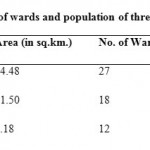 |
Table 1: Area (sq.km), No. of wards and population of three municipalities in Manipur Click here to View table |
The total no. of staffs involved in the SWM activities of the three municipalities is given in the Table-2. The health officer is in-charge of the overall solid waste management in the Imphal municipal area. As per the information from the Imphal municipality, about 150 tons of solid waste is generated per day. Out of which only 70 to 80 tons are collected and disposed daily both by the municipality and the NGOs. In Thoubal and Bishnupur municipality the sanitary inspector is the overall officer in-charge of the solid waste management activities. As provided from the Thoubal and Bishnupur municipality the amount of solid waste generated are 1.0 ton and 0.44 ton respectively from the market area only.
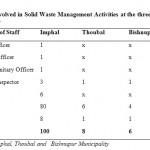 |
Table 2: Staffs involved in Solid Waste Management Activities at the three Municipalities in Manipur Click here to View table |
Collection
The Imphal municipality workers collect waste from the main market daily and from other peripheral markets on a weekly basis. In the morning municipal sweepers sweep market and peripheral roads and collect it in small heaps. Handcarts are used for collection and then the municipal vehicle collects and transports it to disposal site. Waste is also seen outside the bins and roadsides. It shows that the garbage cleaning is not satisfactory resulting in emanation of obnoxious smell in the adjacent areas. In some wards/ areas, NGOs like CRED (Centre for Research in Environmental Development), WUM (Workers’ Union Manipur), TACDEF (Thangmeiband Assembly Constituency Development Forum) and SSF (Seven Security Force) have started house to house collection system charging a fee (Rs.50/- from a house of seven members) per month. But all the wards were not served with door to door collection of waste and collection was done thrice a week from a particular household. So a large amount of waste is either thrown on the streets or disposed off near the river banks. In Thoubal municipality collection is done once or twice in a week depending upon the production and accumulation of waste in the market areas. Door to door collection is not practiced. Wastes are disposed off on the roadsides, ditches and along river banks. Some broken cemented bins are also there in the market areas where the wastes are littering outside. No regular street sweeping is done and wastes remain on the roadside. After 2-3 day the municipal workers collect it and transported to disposal area.
Segregation
Segregation of waste is not practiced and all the wastes are seen mixed up. In the Imphal municipal disposal areas biomedical waste are seen mixed up with the municipal waste. Although some NGOs and private hospitals have started the incineration of biomedical waste still there is improper collection and disposal. Sometimes electronic wastes like TV cabinets, CDs, broken key boards, bulbs and CFL tubes etc. are seen in the disposal site of Imphal municipality. In Thoubal also segregation of waste is not practiced. Wastes are mixed up. Even the biomedical wastes from the district hospital are mixed up with the municipal wastes which are thrown at the bank of the river Thoubal at Thoubal Wangmataba parking area. In some sampling site electronic waste like CDs, CFL tubes, bulbs etc. are also seen mixed up with the municipal wastes. In Bishnupur municipality also the collection system is poor. The municipal workers collect the waste from the market only early in the morning before the shops and other women vendors open. Otherwise the women rebuke the sweepers as there is a belief that if they see the brooms sweeping in the morning when they come for the day’s activities is a sign of bad luck of the day. Waste lies in heaps and is manually loaded to the handcarts and small wheel barrow and finally to the tractor-trailer standing within the municipal campus. The waste is transported later to the disposal site. Sometimes direct burning within the trailer itself is done to reduce the volume. Wastes are also disposed off on the roadsides, ditches and on the banks of the river Thongjaorok. Those households having enough spaces within their premises make their own pit to dispose. In Bishnupur the situation is also the same. No proper segregation of waste is done. Wastes are mixed up. Less amount of biomedical waste like expired tablets, blood stain cotton and medicine bottles are seen. Some electronic wastes are also mixed in the municipal waste.
Storage
Storage facilities are not enough in any of the three municipalities. In Imphal about ten iron bins of nearly 2.4 cu m size are kept in the market areas. The domestic sources of waste are kept mixed in plastic buckets, cartoons, bags, plastic containers, polythene / thermocool box etc. They throw it to roadside collection points. In some wards NGOs dealing with waste management collect the waste in a schedule time. In Thoubal sometimes household wastes are stored in polythene and plastic containers. Small and medium heaps of wastes are seen everywhere. Households having their enough spaces in their premises makes pit in the backyard to dispose. In Bishnupur also people used plastic containers, buckets and polythene to store their waste and disposed it on the roadside and on the river banks. No specific public storage bins are provided. Some people use pit in their backyard for the disposal.
Transportation
The waste collected by the municipality and NGOs are carried to the disposal site by either trucks or tractor-trailer to disposal site about 4-5 kms from Imphal. Some NGOs use DI-Tata in addition to 407-Canter trucks. The transporting vehicles are not covered and scattering and littering of waste is seen on the roads. This is against the Municipal Solid Waste Management Handling Rules. The lifting of the waste is done manually. The present system of loading and unloading of waste is labour intensive. Sometimes JCB machine is used for loading waste in market areas of Imphal municipality following prolong strikes by the municipal employee and workers. Most of the workers do not have any protective measures and are exposed directly to the waste. In Thoubal and Bishnupur transporting vehicle is Tractor-trailer. Sometimes Tata Tipper is used in Thoubal. They remove the waste from the market area only. Table-3 shows type and no. of vehicles used in transportation of waste in the three municipalities.
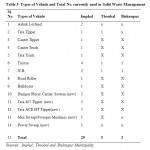 |
Table 3: Types of Vehicle and Total No. currently used in Solid Waste Management Click here to View table |
Disposal
The municipal solid waste is disposed by direct open dumping and not by sanitary land-fill method. Unauthorized and indiscriminate dumping occurs at many places, low-lying land and ditch and on the banks of the river Nambul. The present temporary disposal site of Imphal municipality is nearly 4-5 km away from the city which is owned by a local club, KRYPHSA (Kangchup Road Young Physical and Sports Association), Naoremthong. The area is 10 acres only. The Imphal municipality has its own land of 88 acres for disposal at Lamdeng at a distance of about 12-13 kms away from Imphal, where the construction is going on. In Thoubal also unauthorized dumping on the riverbanks, roadside, and ditches are seen. Individual person asked the municipal authority to dump the market waste to their low-land areas. Most households in this municipality have enough spaces to dispose their domestic wastes in their backyard. Hence there is natural system of degradation. But the inhabitants near the river Thoubal used to throw the waste on the bank of this river. The problem of disposal is facing by the people residing near the market area. The Thoubal municipality has its own land of 26 acres for disposal at Thoubal Khunou which is 2 km away from Thoubal bazar. Presently the wastes are randomly disposed here. Prior to this the municipality constructed a sanitary landfill near a hill at Thoubal Khunou at a distance of about 3 km from Thoubal bazar. But it was failed due to land slide. Thoubal municipality has 26 acres of land but sanitary landfill is yet to be constructed. In Bishnupur also the situation is almost like that of Thoubal. Unauthorised dumping in many places is seen. Here is also the culture of disposing in their backyard pits. The problem is for those residing near the market area. Bishnupur municipality has 4.94 acres of land at Chothe which is nearly 3 km away from the Bishnupur bazar. Sanitary landfill construction is almost complete.
Characterization of Waste Imphal
The data reveals that in Imphal municipality the highest portion of the waste is organic waste (60.59 %) which is biodegradable and second highest is miscellaneous (12.51%). The presence of earthen materials and construction waste indicates rapid urbanization and growth of population leads to construction of new buildings. Among the recyclable materials plastic has the highest percentage composition followed by paper which is more from the high income group. Other recyclable materials like glass and metal shows less percentage composition of 1.86 % and 1.4% respectively. The reason is the rag pickers collect these materials from the houses and disposal site at initial stage. Leather shows the least percentage composition of 0.16 %. Small percentage of electronic and biomedical waste are also associated among the components. The existing system is far from adequate and needs to be improved. The large quantity of organic biodegradable waste (60.59%) which can be converted into organic manure and used for organic farming for which waste has to be segregated initially and fertilizer /compost plant has to be set up. Such a plant has been set up in Jalandhar, Punjab 11. This would help in managing a large part of the waste successfully as well as provide employment opportunity. Thoubal The analysis of the data gives that organic waste is the highest component (60.08 %) among the composition which suggests composting using vermitechnology. And the second highest is the miscellaneous (15.69 %). Presence of ashes in miscellaneous shows the wastes are burnt frequently. The third highest component is plastic (11.1 %) which is followed by paper (6.06 %) and contributed more from the middle and high income groups. It may be because of the fashion of packed foods and easy handling. Other recyclables like glass and metals contribute less percentage because of the waste scavengers that collect recyclables from house to house by paying small amounts. Biomedical waste shares 1.14 % among the composition which is from the middle income groups where District Hospital is near this sampling site. Leather shows the least percentage and little amount of electronic waste are also associated in the municipal waste which are from the high and middle income groups. Bishnupur In Bishnupur municipality also the waste characterization data shows that organic waste is the highest component (57.71%) and the next is miscellaneous (18.8%) and plastic (8.8%). Least component is leather (0.12%). Maximum contribution of organic waste comes from the low income groups. In the miscellaneous component presence of ashes shows that the wastes are burnt down from time to time. Paper and plastics comes more from the high income group. Other recyclables, glass and metals have less percentage contribution and the reason may be because of the waste scavengers that collect recyclables from house to house by paying small amounts. Least amount of leather shows no leather industries and other leather works in the state as well. Very small amount of biomedical waste from the households comes in municipal waste. The different components of the waste in the three municipalities are shown in Table-4 and Fig 1 shows the comparative graph of the different components of the waste in the three municipalities.
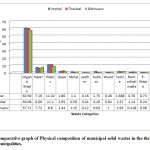 |
Figure 1: Comparative graph of Physical composition of municipal solid wastes in the three Municipalities. Click here to View figure |
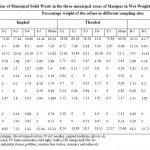 |
Table 4: Physical Composition of Municipal Solid Waste in the three municipal areas of Manipur in Wet Weight Basis Click here to View table |
ROLE oF Ngos
In Imphal municipality the participation of NGOs in the waste collection system have been started from August 2007 after the municipality had privatized the collection system on 23rd July 2007 to improve the system under public private partnership. The following Table-5 shows the name of the NGOs and the areas (wards) covered for the services.
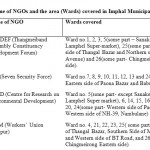 |
Table 5: Name of NGOs and the area (Wards) covered in Imphal Municipality Click here to View table |
There is another NGO named KWAMS (Khaba Waste Management System). They collect waste from the ward no. 23 only within the municipal areas with the understanding of WUM (Workers’ Union Manipur). They also collect from the private and government offices and institutions. They mainly cover the areas beyond municipality. Each and every household are not subscribed to the respective NGOs. In ward no 24 and 25 the main markets and other business establishments subscribe to the four NGOs who cover two wards each and also earn revenue. Collection is done daily. Local clubs and meirapaibees (women’s organization) also extend social services especially during some strikes of the municipal workers. Monthly charges/fee by the NGOs was Rs.100 per month for household/ shop/hotels/restaurants/ offices within the commercial areas and Rs.50 per month for household/shop/hotels/restaurants/ offices within the non-commercial areas. There is a suggestion to raise household charge to Rs.70. The frequency of collection is not satisfactory.
Role of Informal Sector
Other then municipality/ULBs and NGOs, the informal sector can also contribute to the management of municipal solid waste. It comprises of rag pickers, kabaris, middlemen and recycling factories, which pick up and recycle the waste in a stream away from the municipality. It plays a crucial role in lightening the burden on government exchequer and municipality by recycling. They generate self-employment by collection, segregation and recycling in a more organized and safe manner. They not only create better living conditions but also basic rights to work.
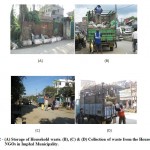 |
Figure 2: (A) Storage of Household waste. |
Conclusion
In conclusion it can be said that the present system of management should be upgraded. Segregation of waste at source for recyclable material should be encouraged so that the quantity of waste to be disposed shall be minimized and recycling should be adopted. Frequency of collection and transportation to disposal site should be improved to avoid health hazards and to ensure aesthetic environmental condition. Awareness among the public can help the proper management of municipal solid waste. NGOs should also be able to participate in or influence policy making. Earmarking “No Litter Zones” should be introduced. Mechanisms by which smaller entrepreneurs, civil society etc. can participate in new waste management procedures and regimes should be developed. The municipality should coordinate with other local civic bodies, NGOs and Community Based Organizations (CBOs). They should also undertake phased programs to ensure community participation such as regular meetings with local resident welfare associations, etc. NGOs can also develop recycling units and generate resource. They can become entrepreneurs and this can lead to employment generation and economic betterment of the region. NGOs can also make remarkable contribution in the management of municipal solid waste.
Acknowledgment
The authors are thankful to the Department of Ecology & Environmental Science, Assam University, Silchar where the work was carried out. This paper has been presented at the 4th International Conference on Solid Waste Management, January 28-30, 2014, Hyderabad, India. The authors are grateful to the organizers of 4th, Icon SWM, 2014.
References
- Kansal, A., R.K. Prasad and S. Gupta, Delhi Municipal solid waste and environment- an Appraisal. Indian Journal of Environmental Protection, 18(2):123-128 (1998).
- Singhal, S. and S.Pandey, Solid Waste Management In India : status and future directions.TERI Information Monitor on Environmental Science (TIMES), 6 (I) :1-4 (2001).
- Central Pollution Control Board (CPCB), Management of Municipal Solid Waste. New Delhi, India (2000).
- Chouhan, B.M. and B.K. Reddy, Bio-energy scenario in India. IREDA News, 7(1): 20-27(1996).
- Mazumdar, N.B., Municipal solid waste management the Indian perspectives. Environment Monitor, 12(2): 257-269 (1994).
- Pandey, S.K., P. Tyagi, Anil K. Gupta, Municipal solid waste management in Ghazipur city- A case study. Journal of Agricultural and Biological Sciences, 2(6): 41-43 (2007).
- Statistical Abstract Manipur, Directorate of Economics and Statistics, Government of Manipur (2004).
- Nanda, S.N., Mishra, B. and Tiwari, T.N., Municipal solid wastes in Hirakud town (Orissa). (1) Preliminary survey. Pollution Research, 22(2): 289-292 (2003).
- Ingle, S.T. and Mali, D.S., Solid waste management system for Kolhapur city, Maharashtra. Pollution Research, 19(2):185 (2000).
- Malviya, R., Choudhary Rubina and Buddhi Dharam, Study on solid waste assessment and management-Indore city. Indian Journal of Environmental Protection, 22(8): 841-846 (2002).
- Puri,A, Kumar,M and Johal,E. Solid waste management in Jalandhar city and its impact on community health. Indian Journal of Occupational and Environmental Medicine, 12(2):76-81 (2008).







